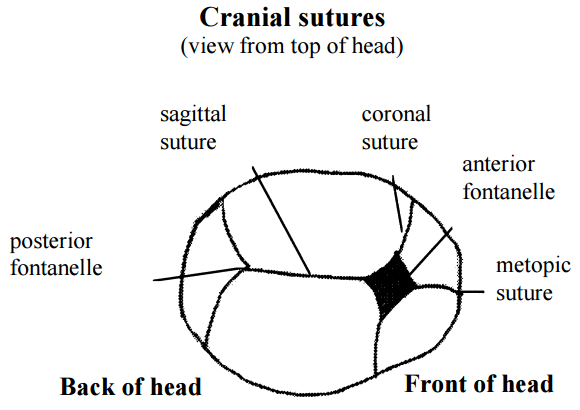Craniosynostosis
What is craniosynostosis?
A cranial suture is where sections of the skull meet. In some babies, the sutures close too early. This is called craniosynostosis (kray-nee-oh-syn-oh-stow-sis). It results in an abnormal head shape. The face may also be affected.

There are different types of craniosynostosis based on which cranial sutures are involved (see picture above), and different shapes of the head that can occur.
- brachycephaly (bray-kee-sef-a-lee):
a two-sided closure of the coronal suture; receding lower forehead and bulging upper forehead - plagiocephaly (play-jee-oh-sef-a-lee):
a one-sided closure of the coronal suture; one side of the head is flat - oxycephaly (ox-ee-sef-a-lee):
a two-sided closure of the coronal suture; pointed head - scaphocephaly (skay-foh-sef-a-lee):
the sagittal suture; long, narrow head - trigocephaly (try-goh-sef-a-lee):
the metopic suture; triangular-shaped forehead - turrecephaly (tur-eh-sef-a-lee):
a two-sided closure of the coronal suture; long, narrow head
What is the treatment?
Surgery is needed to reposition and shape the bones and soft tissue of the head. Then the brain can grow and shape the head more normally as the child grows.
What should I expect after surgery?
Your child may spend up to 24 hours in the pediatric intensive care unit (PICU) after surgery. Then your child is transferred to a medical/surgical unit.
Your child will have a large bandage covering the head. The face and eyes will look swollen and bruised after surgery. This may increase during the first 3 days and is usually gone after 7 days.
The nurses may apply ointments to your child's eyes while they are swollen shut to keep the eyes from becoming dry and sore.
An IV (very small tube in the vein) will be used to give fluids and medicines. Antibiotics will be given to decrease the risk of infection.
Acetaminophen (such as Tylenol®) is most often used to control pain. Sometimes stronger pain relievers are needed and can be given through the IV.
Your child's hemoglobin will be checked and a blood transfusion may be needed to help ensure proper healing and recovery.
We will keep a record of how much your child drinks and eats, as well as the urine and bowel movements.
The head of the bed will be raised to at least 30 degrees to help decrease the swelling.
How active may my child be?
The first few days after surgery, your child should stay in bed. Encourage quiet activities, such as listening to music and stories.
What can I do to help my child?
The temporary loss of your child's vision, due to swelling, can be scary. Here are some things that may help:
- Speak softly so as not to startle your child.
- Tell your child who you are.
- Touch his or her hand so your child knows you are there.
How should I care for my child at home?
Protect the head from injury.
Keep your child's head and shoulders raised up on a pillow when lying down to decrease swelling.
Keep the incision clean and dry until your doctor tells you it is okay to wash it. Until that time, do not wash or soak it; give your child sponge baths.
When it is okay to start cleaning the incision, follow these steps once a day, or as often as your doctor says.
- Wash your hands with antibacterial soap rubbing all surfaces briskly, or use an alcohol hand sanitizer.
- Dampen a clean washcloth with water and apply antibacterial soap.
- Use a gentle circular motion to clean from one end of the incision to the other.
- Rinse the washcloth, and with a gentle circular motion, rinse from one end of the incision to the other.
- Gently pat dry with a clean cloth.
- Apply a small amount of antibiotic ointment to the incisions, if ordered by the doctor.
- Wash your hands again.
Use sunscreen on the scar to prevent permanent darkening. Do this for 1 year.
See the Discharge Instruction sheet for more specific instructions.
When should I call the doctor?
- temperature higher than 101.5° F
- incision becomes reddened, swollen, warm to the touch, or more painful
- pus or other drainage from the incision
- vomiting
- increased irritability (fussiness)
- increased sleepiness
Questions?
This sheet is not specific to your child, but provides general information. If you have any questions, please call the doctor.
Children's Hospitals and Clinics of Minnesota
Patient/Family Education
2525 Chicago Avenue South
Minneapolis, MN 55404
Last reviewed 8/2015 ©Copyright
This page is not specific to your child, but provides general information on the topic above. If you have any questions, please call your clinic. For more reading material about this and other health topics, please call or visit Children's Minnesota Family Resource Center library, or visit www.childrensmn.org/educationmaterials.
© 2024 Children's Minnesota
